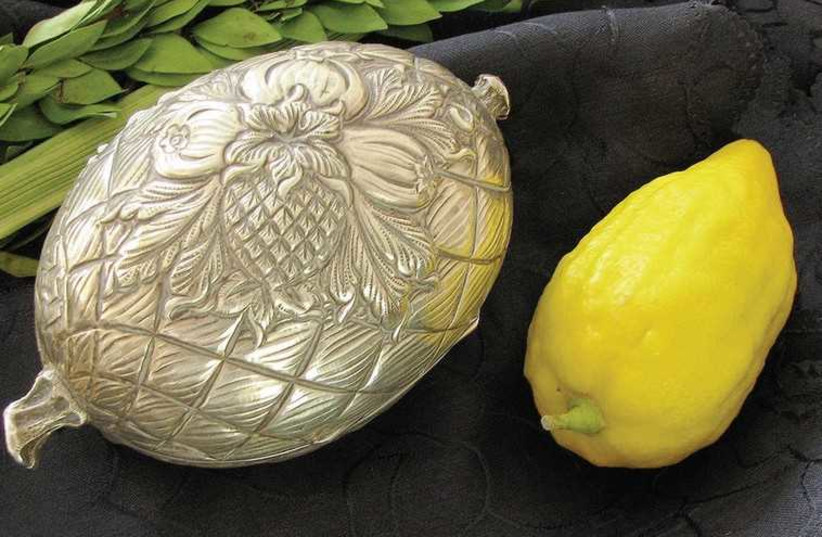The etrog (citron) has a surprisingly lofty standing in Jewish law, literature, culture, folklore, history and art. For six days each fall, it is used in a religious ceremony, one of the Four Species legislated by the Bible in Leviticus 23:40. Yet the other three – the lulav (palm frond), hadas (myrtle), and arava (willow) – never achieved the same status.
This cannot be because of its taste – most people consider it inedible – or because of its habitat. Etrog trees are not even indigenous to the Middle East; they probably originated in China.
Warren Klein, Sharon Liberman Mintz and Joshua Teplitzky have edited a collection of 18 fascinating essays that outline and explain the appeal of the etrog: Be Fruitful! The Etrog in Jewish Art, Culture, and History.
This handsome volume contains dozens of reproductions, many of them in color, of works of art containing etrogim, from the first century to the 21st. The essays point out that illustrations of etrogim often show up in unexpected places – for example, in illuminated Passover Haggadot or in works of art by Christians, both philosemites and antisemites, depicting Jews or Judaism.
The history and importance of the etrog
Etrogim were difficult to obtain in many places where Jews lived, perhaps contributing to their allure. An essay by Debra Kaplan and Edward Fram outlines how “the availability of each of the three species [other than willows, which grow in many countries] was an old problem for Jews living in northern Europe.” Some communities saved palm fronds and myrtles from year to year, but an etrog doesn’t last. Kaplan and Fram tell how one year a number of Jewish communities near Vienna managed to import just one etrog; they chopped it up so that each community would have at least one piece. The local rabbinic scholar “[Rabbi Israel] Isserlein [deceased 1460] did not approve.” Later, “Rabbi Moses Isserles of Cracow (d. 1572)... toyed with the idea of using lemons and oranges to fulfill the commandment” before ultimately concluding that an etrog was required.

A few essays in the volume describe the status of the “esroger,” Yiddish for etrog merchant. This importer/purveyor of a rare commodity could have taken advantage of the strong demand and limited supply. But as Joshua Teplitzky shows, “The esroger was not an agent of free enterprise. Or, at least, different Jewish authorities attempted to prevent him from being one,” through restrictive community legislation. Yiddish comedic performances occasionally mocked esrogers as overly mercenary people.
Jonathan Sarna’s essay describes the problems of acquiring kosher etrogim in the earliest years of the Jewish community in the United States, even though citron trees grew in the Americas. (Thomas Jefferson, for one, grew citrons.) Orthodox authorities of Jewish law worried that the etrogim in the Americas were hybrids of lemons and citrons, not pure enough for use in the religious ceremony. Reform Rabbi Isaac Mayer Wise of Cincinnati (1819-1900) wrote: “If you have no esrog, no lulav etc., oranges, grapes, pears and apples will do, not to be shaken but to be gratefully enjoyed as God’s blessing bestowed upon our beautiful land.”
The Talmud teaches that the mitzvah can be observed only if you own the etrog you use, although it permitted transferring ownership as often as desired. Alexander Kaye’s essay explains that this caused an unusual problem within the small movement of religious kibbutzim in Israel in the early 20th century. In its formative years, the movement rejected the idea of private property. Everything in the kibbutz, including an etrog, belonged to the kibbutz. They arrived at a solution in 1957. A new clause was written into the kibbutz bylaws, stating that “individual members of the kibbutz may personally own whatever is needed to observe a Torah law, such as... an etrog.”
The etrog also played a strong role in Jewish folk religion. One common belief was that if a pregnant woman bit off the tip of the etrog on the last day of the holiday, she would have an uncomplicated birth. Beliefs in the etrog’s medicinal properties were also common. Efraim Lev and Zohar Amar, in their essay, even claim that “modern medicine... has rediscovered some of the enduring medicinal qualities of the etrog.”
TWO ANCIENT stories – one told by Josephus in the first century and one by the Talmud a few centuries later – describe the use of etrogim as projectiles during intra-Jewish disputes. In Josephus’s telling, as Steve Weitzman’s essay shows, “the etrog-throwing incident... was part of a larger and tragic pattern of intra-communal conflict that eventually precipitated the destruction of the Second Temple.”
Happily, in later years the symbolism of the etrog changed. Later rabbis interpreted “the etrog, along with the other three species... as a sign of Jewish unity, each of the species symbolizing a different kind of Jew bound together by the holiday.”
Be Fruitful! The Etrog in Jewish Art, Culture, and History
Edited by Warren Klein, Sharon Liberman Mintz and Joshua Teplitzky
Mineged Publishing House
271 pages; $74.50
